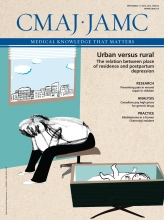The Cochrane Collaboration

Image courtesy of © 2013 Thinkstock
The Cochrane Collaboration is the largest single producer of systematic reviews of the effects of health care interventions. This month, the collaboration celebrates its 20th anniversary at the 21st Cochrane Colloquium in Quebec. Cochrane reviews are currently available free of charge to people in low-and middle-income countries, and Cochrane is seeking to make all of its reviews entirely open access in the future and to expand the number of languages in which its reviews are published. See Commentary, page 1117
Geography and postpartum depression
Women who are isolated and live in large urban centres are at greatest risk for postpartum depression. In this national survey, geographic location, including accounting for connectivity to nearby urban centres, was less important than the distribution of other factors that accompany social isolation, such as immigrant status, interpersonal violence, self-perceived health and social support. The authors suggest that some of these factors are potential targets for prevention and remediation. See Research, page 1129
Preventing pain in wound repair

Image courtesy of © 2013 Thinkstock
Tissue adhesives polymerize through an exothermic reaction that can cause a painful burning sensation. Despite this, topical analgesics are not commonly applied when tissue adhesives are used to repair lacerations in children. In this randomized, placebo-controlled, blinded trial, Harman and colleagues show that children who had a lidocaine–epinephrine–tetracaine solution applied before laceration repair with tissue adhesive had a clinically significant decrease in pain scores as well as better wound hemostasis. See Research, page E629
Group medical visits for diabetes care
Group medical visits for patients with diabetes had a positive effect on clinical and patient-reported outcomes, with significant reductions in glycated hemoglobin. This finding comes from a meta-analysis of 13 randomized controlled trials examining the effect of group medical visits on various outcomes of diabetes care compared with standard one-on-one care. See Research, page E635
Getting competitive with generic drugs
Canadians pay more for generic prescription drugs than consumers in comparable countries, but that may soon change. The provincial premiers’ commitment to use competitive bidding to lower prices could net substantial savings. However, Law and Kratzer caution that the initiative should include as many drugs and provinces as possible and that some generic drugs should be publicly covered. See Analysis, page 1141
Empyema in a teenage boy
A previously healthy 17-year-old boy presented with cough, fever and left-sided chest pain. Pneumonia with a parapneumonic effusion was diagnosed. Despite a management approach supported by evidence-based guidelines, his condition worsened and empyema developed. Why didn’t his pneumonia respond to standard treatment? Rayment and Weinstein tell us why. See Practice, page 1151
Chernobyl and glioblastoma

Image courtesy of © 2013 Thinkstock
A 39-year-old man presented with a 5-month history of self-described personality changes. He was found to have an aggressive glioblastoma that did not respond to treatment. He had been living in the Chernobyl area at the time of the atomic disaster and for several years thereafter. Dmytriw and Pickett review the relation between exposure to ionizing radiation from nuclear accidents and development of malignancies in the short and long term. See Practice, page 1154
Complications after atrial ablation

Image courtesy of © 2013 Thinkstock
Ablation for atrial fibrillation is a common procedure, but there can be serious complications, such as left atrial–esophageal fistula. The diagnosis of left atrial–esophageal fistula requires a high index of suspicion, because its presentation is nonspecific and may be mistaken for other conditions. Singh and Nault caution that esophageal manipulation in a patient with a fistula can have catastrophic consequences. See Practice, page 1158








